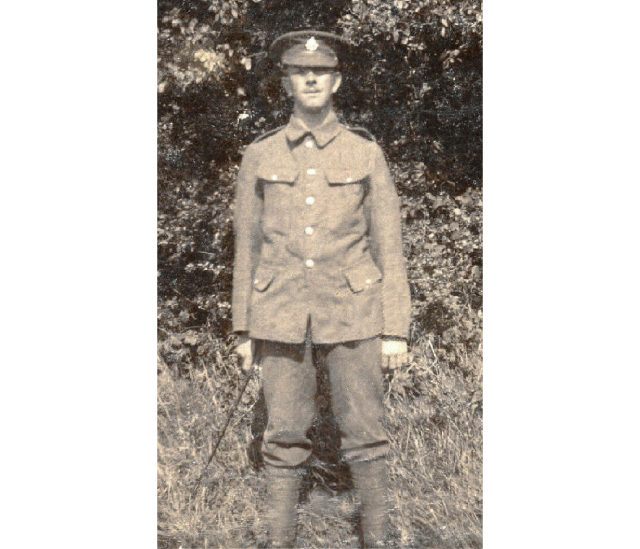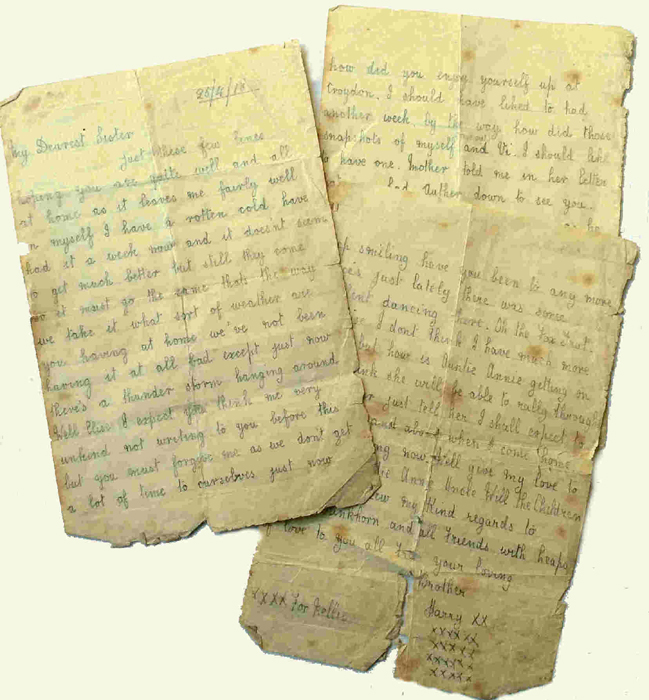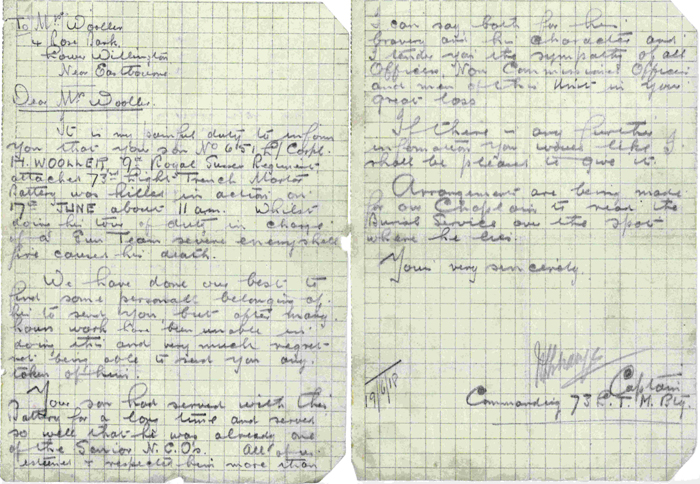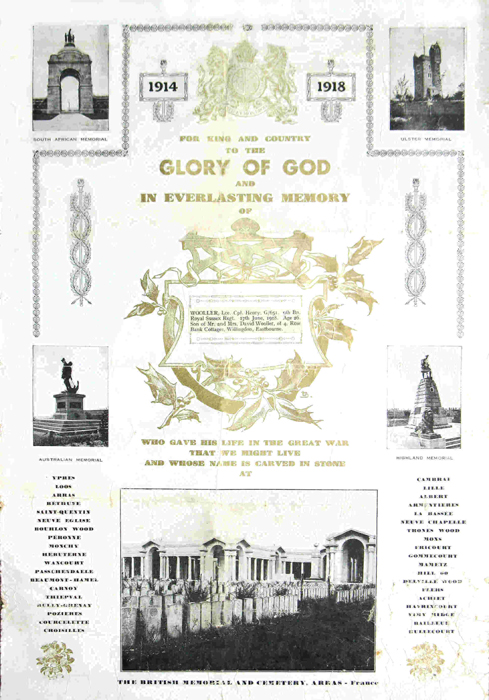L/Cpl. Henry Wooller Killed 17 June 1918 aged 27
G/651 9th Bn Royal Sussex Regiment
Henry Wooller, was born at Malthouse Cottages Red Lion Street Willingdon on 30 November 1890. He was the elder of two sons of David and Emily Wooller with a younger sister Elsie, my grandmother. Harry was typical of many of the young men of Sussex to respond to Kitchener’s call. Born in one of the county’s villages, he grew up where his family had lived since the early 17th century and together with friends from other old Willingdon families enlisted in the County’s regiment. Harry was one of the first men from Willingdon to enlist, joining the 9th Bn Royal Sussex Regiment on 29 August 1914 at the Eastbourne recruiting office, an empty shop, on the corner of Gildredge Road and Terminus Road opposite the Railway Station. The queue of young men waiting to enlist sometimes stretched from the office along Terminus Road around the corner and up Grove Road towards the Town Hall. There was a further recruiting office at the Ordnance Yard in Seaside.
His younger brother Ernest enlisted in the 12th Bn of the same regiment a couple of weeks later. Harry was a master butcher, working for Vines the village butchers on the corner of Red Lion Street and Butts Lane in Willingdon village and lived with his parents at 4 Rosebank Willingdon. He was among the 352 recruits of the 9th Bn to march through Eastbourne on 14 September 1914 from the Ordnance Yard [Seaside] to the railway station. This was the first contingent of new recruits to leave Eastbourne for the newly constructed Cooden Mount Camp. That day the streets of Eastbourne were crowded with hundreds of well wishers. Seaside was packed with onlookers as the young men left with recruiting officer Captain Argall and Mr Claude Lowther MP of Herstmonceux who had formed this new Sussex battalion. Along the whole route were unprecedented scenes with people cheering, waving hats, handkerchiefs and flags encouraging the young men who were led by the drum and bugle band of St George’s Cadet Corps. The train was due to leave between 4 and 4.30pm and with such a crush there was difficulty keeping the ranks intact as they reached the station yard.
Harry’s parents, sister Elsie and younger brother Ernest had managed to get inside the station to wave him off and although spirits were high there was much emotion among the families seeing these young men leaving to go to war. In the station the Municipal Band directed by Mr Hirum Henton encouraged the crowd to sing along as the band played and recruits sang ‘It’s a long way to Tipperary’ and other patriotic songs as they boarded. Each man was given a packet of cigarettes donated by a local Eastbourne lady Mrs Schofield and young ladies went along the carriages handing out the packets to the recruits. As the train steamed out of the station the band played ‘Auld Lang Syne’ with all the troops singing and waving from the carriage windows. A tremendous cheer went up as the train pulled away from the station. People packed Cavendish Place bridge and various points along the track to watch the train leave the town.
The 9th Bn Royal Sussex Regiment was formed at Chichester during September 1914. Harry left Cooden before Christmas with his battalion and was billeted at Portslade. Training continued throughout the winter on the Downs around Brighton. In spring 1915 his battalion moved to the Army Training Camp at Shoreham. He sent postcards home telling of the more intense training with an emphasis on the digging and construction of trenches not so easy with solid chalk not far below a shallow layer of soil. Along with instruction in the use of machine guns, mortars and small arms was physical exercise often with a vigorous early morning march starting at dawn. At the camp more huts were under construction to accommodate the increasing number of troops in addition to the area of tents. In June the battalion was moved to Woking where the final training was carried out including the procedure for gas attacks. On 31 August 1915 his battalion travelled to Southampton where Elsie was waiting to see her brother board SS ‘La Marguerite’ bound for Boulogne France. The ship docked in France the following day 1 September 1915 the men staying in a reception camp for 24 hours after disembarking.
Weather was not good on 3 September as they made a 20 hour train journey to Maresquel. The men’s clothes and equipment were drenched taking several days to dry out whilst they were billeted in barns, outhouses and farm buildings near the village of Rimboval. It was here the troops had to practise repeatedly getting on and off London buses which had been requisitioned for use as transport. In the end the men in full kit took just 35 seconds to fill or empty a bus.
On 21 September the battalion made the first of three gruelling 7 hour marches. This was repeated for two further days in succession in order to take up position for their first battle at Loos. It was a disaster with the inexperienced men exhausted from the marching and Harry recorded they went without food and water for two days. Not surprisingly the casualties proved to be the heaviest of the war for the 9th Bn Royal Sussex.
Conditions were dreadful with continuous heavy rain causing trenches to flood and collapse. The men worked day and night to shore up and repair trenches to give themselves some cover. Harry spent his first Christmas abroad in camp, some 30 miles away from the front line at Houlle. They had a good hot Christmas dinner and entertainment even going to the cinema. So Christmas was spent relatively safely and cheerfully. He wrote of the awful conditions back in the trenches in February 1916, the men sodden and filthy with mud, the ground reduced to the consistency of soft butter. So it was a relief when they were offered comfortable but cold billets and barely luke warm baths after a train journey to Poperinghe. It was to be three more weeks before he enjoyed the rarity of a hot bath, then particularly welcome as there was thick snow at that time.
Gas attacks were also becoming more of a problem and wearing masks for any length of time was very uncomfortable. Again lack of food and water supplies caused additional hardship when they were at the Front. Spirits were raised when the men received welcomed gifts from the ‘Sussex Soldiers’ Cigarettes and Comforts Fund’. Parishioners in Willingdon regularly collected for this and items included peppermints, tins of sausages, sometimes chocolate or boiled sweets and always Woodbine cigarettes. The fund was coordinated by Miss Adams, the secretary, who lived at St Leonard’s and a team of ladies in various parishes across the county organised the collections.
Rare periods of leave were a great relief, the peace of rural Willingdon contrasting sharply with the dreadful conditions back in France or Belgium. In late summer 1916 his leave was a very emotional time, his younger brother Ernest having been killed weeks earlier on 30 June at the battle of the Boar’s Head Richebourg. Over time Harry lost cousins and pals from the village including Albert Hendley killed in 1917 on the first day of the battle of Passchendaele, a month before he and Harry’s sister Elsie were due to be married in the parish church.
Moral was boosted when concerts were organised. Harry wrote of these in his letters home and of football matches, officers versus other ranks. In his last letter to Elsie written 25 April 1918 he wrote “There was some excellent dancing here, Oh the Fox-trot! I went to the theatre last night and my word it was good. I suppose you will think now we are having a ripping time but I can’t tell you all or you really wouldn’t think so.”
Harry survived much heavy action in major battles, without injury; Loos, the Somme, Ypres, Passchendaele. He was promoted to Lance Corporal at the summer of 1916 and was a senior NCO in charge of a Light Trench Mortar Gun Battery. His last leave had been a few brief days at home in the spring of 1918. He wrote home to his parents at the beginning of June nine days before he was killed, whilst billeted at Maroc near St Brebis and Loos. He was suffering a very heavy cold with a fever but was keeping going and wrote about an outbreak of the influenza with more than a hundred of their men already in field hospitals. He was looking forward to his next spell of leave at the end of the month saying ” give them my love till I come home, it won’t be long now”. That was not to be.
As supporting artillery, he had been part of a raid on a German machine gun position, when two of the enemy were taken prisoner. On 17 June, what was described as a quiet day with little enemy action, he was leading a gun team of three men when their position came under heavy enemy shellfire and they suffered a direct hit at about 11am. Those who died with him were, privates Jack Ernest Hope G/16510 from Newhaven, Henry Kennedy G/19297 from Blackburn, Michael McDurmott G/16874 from Heston Durham. His commanding officer wrote to his parents telling of the circumstances of his death and how highly he was regarded among the officers and men. None of the men in Harry’s team who were killed with him have a known grave and all are commemorated on the Arras Memorial Pas de Calais France. Henry’s name is inscribed on Bay 6 of the Memorial which is situated in the Boulevard du General de Gaulle in the western part of the town of Arras. 2,651 Commonwealth graves are located here and 34,795 names are recorded on the Memorial, all casualties from the Arras sector from spring 1916 until 7 August 1918. The 9th Bn Royal Sussex Regiment served on the Western Front for longer than any other Battalion of that Regiment
The following letter was sent to Harry’s parents telling of the circumstances of his death:
To Mrs Wooller
4 Rose Bank
Lower Willingdon
Near Eastbourne
It is my painful duty to inform you that your son No 651 L/Corpl H Wooller 9th Royal Sussex Regiment attached 73rd Light Trench Mortar Battery was killed in action on 17th JUNE about 11am. Whilst doing his tour of duty in charge of a Gun Team severe enemy shell fire caused his death.
We have done our best to find some personal belongings of his to send you, but after many hours work have been unable in doing this and very much regret not being able to send you any token of him.
Your son had served with the battery for a long time and served so well that he was already one of the Senior NCO’s. All of us esteemed and respected him more than I can say both for his bravery and character and I tender you the sympathy of all Officers, Non Commissioned Officers and men of this unit in your great loss.
If there is any further information you would like I shall be pleased to give it.
Arrangements are being made for the Chaplain to read the burial service over the spot where he lies.
Yours very sincerely
19/6/18 Captain Commanding 73rd L T M Battery
Harry is commemorated on the memorial in Willingdon Church and the Roll of Honour in the Willingdon Memorial Hall, which was built in memory of the men of the parish who gave their lives. His name is also inscribed on one of the panels in the Royal Sussex Regiment St George’s Chapel in Chichester Cathedral.
This story was submitted by Rosalind Hodge, Archivist, Willingdon Parish Church











